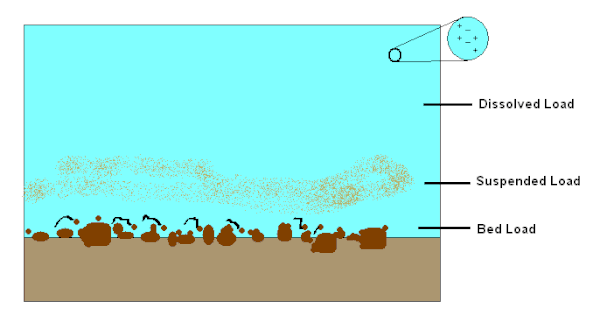Dissolved load
Dissolved load is the portion of a stream's total sediment load that is carried in solution, especially ions from chemical weathering. It is a major contributor to the total amount of material removed from a river's drainage basin, along with suspended load and bed load. The amount of material carried as dissolved load is typically much smaller than the suspended load,[1] though this is not always the case, particularly when the available river flow is mostly harnessed for purposes such as irrigation or industrial uses. Dissolved load comprises a significant portion of the total material flux out of a landscape, and its composition is important in regulating the chemistry and biology of the stream water.

The dissolved load is primarily controlled by the rate of chemical weathering, which depends on climate and weather conditions such as moisture and temperature.[2] Dissolved load has many useful applications within the field of geology, including erosion, denudation, and reconstructing climate in the past.
Measurement techniques
Dissolved load is typically measured by taking samples of water from a river and running various scientific tests on them. First, the
Applications
Reconstructing climate
Dissolved load can provide valuable information about the rate of
Denudation
Salt export
The process of carrying salts by water to the sea or a land-locked lake from a river basin is called salt export. When adequate salt export is not occurring, the river basin area gradually converts into saline soils and/or alkali soils, particularly in lower reaches.[6]
Dissolved loads of selected major rivers
| River | Drainage area, 106 km2 | Discharge, 109 m3/yr | Total dissolved solids (TDS), 106 tonnes/yr |
|---|---|---|---|
| Xijiang | 0.35 | 30 | 10.14 |
| Changjiang | 1.95 | 1063 | 226 |
| Huanghe | 0.745 | 48 | 84 |
Ganges-Brahmaputra
|
1.48 | 1071 | 129.5 |
Lena
|
2.44 | 532 | 50.6 |
| Amazon | 4.69 | 6930 | 324.6 |
| Orinoco | 1.00 | 1100 | 51.3 |
| Krishna | 0.251 | 30 | 10.4 |
| Godavari | 0.31 | 92 | 17 |
Kaveri
|
0.09 | 21 | 3.5 |
| Ganges | 0.75 | 493 | 84 |
| World total | 101 | 37000[9] | 3843.0 |
See also
References
- S2CID 129669714.
- ISSN 0009-2541.
- ISSN 0022-1694.
- ISSN 0016-7037.
- ISSN 0148-0227.
- ^ "Hydronomic Zones for Developing Basin Water Conservation Strategies" (PDF). Retrieved 12 July 2015.
- ISSN 0148-0227.
- ^ "Mass transport in krishna river basin (Table-5)" (PDF). Archived from the original (PDF) on 19 June 2015. Retrieved 25 April 2020.
- ^ "Ground Water-Making the invisible visible (page 13), The United Nations World Water Development Report 2022" (PDF). Retrieved 5 April 2022.
